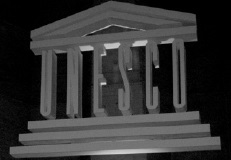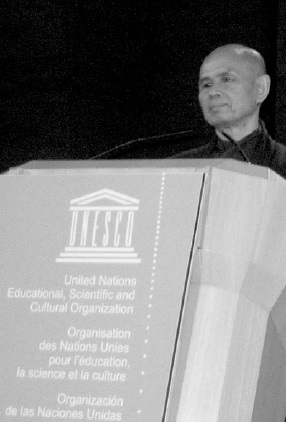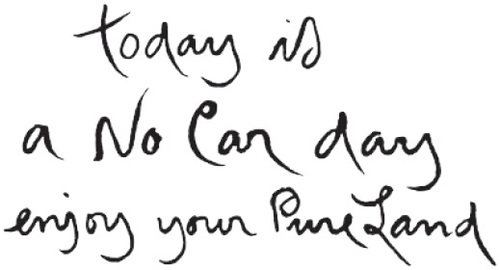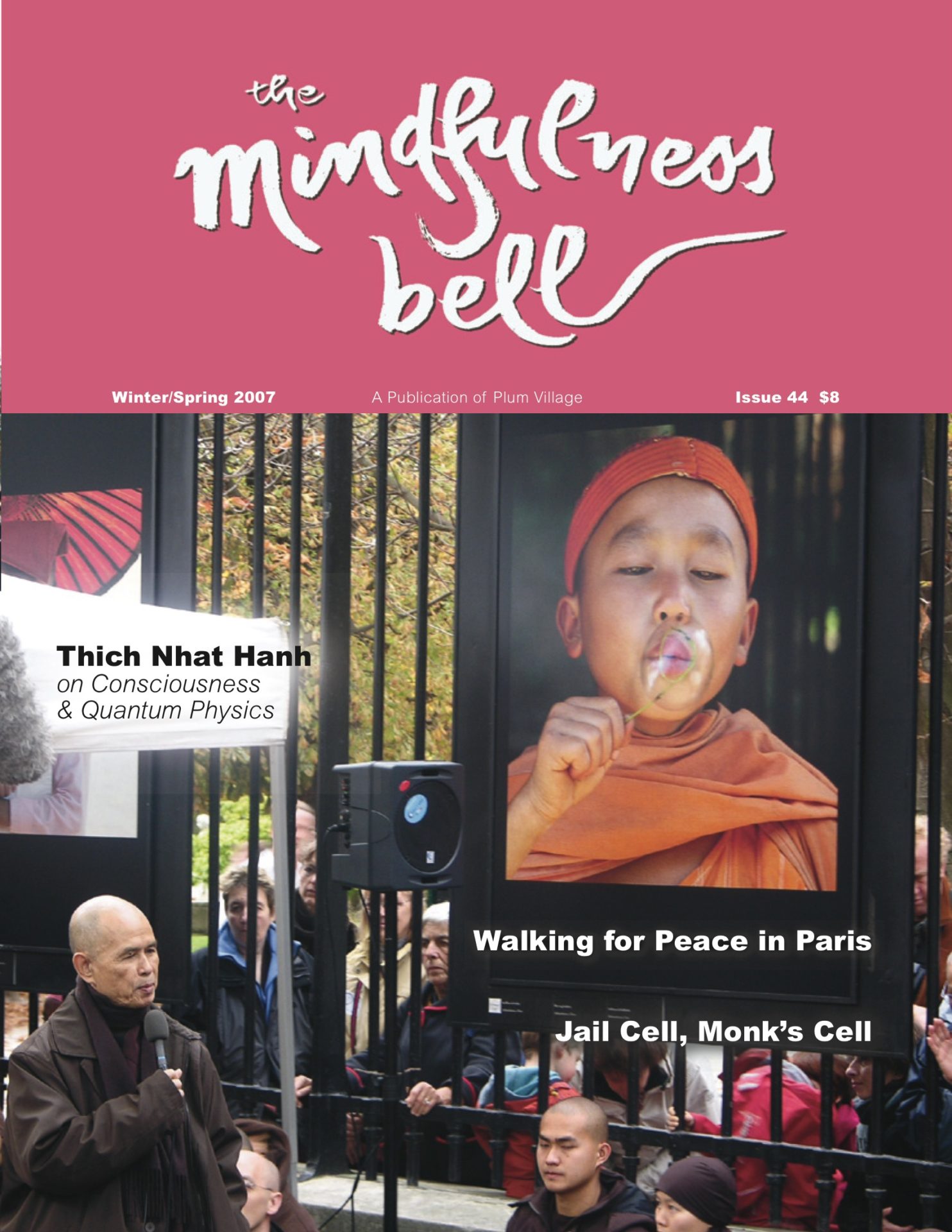Speech to UNESCO in Paris, October 7, 2006
By Thich Nhat Hanh

Ten years ago, I was asked by the director of UNESCO, his Excellency Federico Mayor, to write a manual on the practice of peace and nonviolence, and I readily accepted the work. For me, writing this manual was an easy thing to do, because in Plum Village where I live and practice,
Speech to UNESCO in Paris, October 7, 2006
By Thich Nhat Hanh

Ten years ago, I was asked by the director of UNESCO, his Excellency Federico Mayor, to write a manual on the practice of peace and nonviolence, and I readily accepted the work. For me, writing this manual was an easy thing to do, because in Plum Village where I live and practice, we do nothing but practice peace and nonviolence — all year round. There are about three hundred monastics and lay people who live together in Plum Village, and what we learn everyday is to be peace and to do peace. Our center is also open to friends from all over the world to come and practice, and about five to ten thousand people come every year to learn to be peace and to practice peace and nonviolence. That is why I was ready to accept the work of writing the manual, which took about one year to finish with the help of the Dharma teachers in Plum Village.
When you come to Plum Village, you learn how to breathe so that peace, happiness, and freedom are possible; how to walk so that you can enjoy every step, and so that every step can be refreshing, healing, and nourishing; how to sit so that peace, understanding, and wisdom become possible. We also learn to eat our breakfast and do our dishes in way that makes freedom, peace, brotherhood, love, understanding, and joy possible; and the practice is continuous.

We have offered the practice of peace to many different kinds of people including children, students, parents, school teachers, police officers, ecologists, psychotherapists, business leaders, and others. The children who come to Plum Village practice very well, and they are capable of being peace and practicing peace. We offer different kinds of retreats to serve different kinds of people in their desire to practice nonviolence and peace.
We once offered a retreat in the United States of America for police officers and for corrections-center administrative personnel. You can picture those police officers now, practicing mindful breathing and mindful walking while patrolling the streets. Those police officers are now capable of using loving speech and deep listening in order to restore communication between themselves and their families. Everyone can practice, including politicians. We have offered a retreat for members of Congress in Washington, D.C. and there are now congressmen and senators who practice walking meditation on Capitol Hill. They know how to do walking meditation from their office to the place where they cast their votes. We have also offered the practice for people who are in prison, and there are now practitioners in prison enjoying breathing, sitting, and walking, and they suffer much less. Also among the people who come to our center to practice are many school teachers, and they are able to bring the practice to their classrooms to help their students suffer less.
Proposal 1: An Institute for Peace
Over the years, we have trained more than f ive hundred Dharma teachers in the practices of Plum Village, and they can offer the practice of peace and nonviolence in a non-sectarian way. If UNESCO wants to set up a school for the practice of peace, we can afford to offer teachers — both monastic and lay — and we don’t need any salary.

The peace manual was completed several years ago and it was published as a book by Riverhead. We have added a number of anecdotes and stories in order to make it pleasant for our readers, but it is essentially a manual for the practice of peace and nonviolence. We know that there is violence within us, and that there are also fear, despair, and anger in us. We should know how to recognize, embrace, and transform the violence and anger within. In Plum Village, we don’t just speak about nonviolence and peace — we try to do it. Once we have been able to transform the violence in us, we can help other people around us to do the same. We can help other people recognize, embrace, and transform the violence and suffering in themselves, and these are very concrete ways to practice.
Over the years, we have sponsored many Palestinian and Israeli groups to come to Plum Village to practice with us. In the beginning, it is always very difficult for the two groups to look at or speak to each other, because everyone has a lot of fear, anger, despair, hate, and misunderstanding. Therefore, their practice during the first week is just breathing and walking mindfully, so they can calm down and recognize the energy of anger, fear, and violence in themselves, and they can get a kind of relief. After about ten days, we introduce them to the practice of deep, compassionate listening. In this practice, you listen with all your heart in order to give the other person a chance to empty his or her heart. There is a lot of suffering within the other person, and maybe no one has ever been able to listen to him or to her. One hour of listening like that can bring a lot of relief to the other person. The group of Israelis sit quietly in order to listen to the Palestinians and vice versa. You have the right to say what is in your heart, but you should use the kind of language that will help the other person or the other group of people to get the message, and this kind of language is called loving speech. You are not supposed to argue, condemn, or blame, but you can tell everything, with the condition that you use loving speech.
Practicing like that and speaking like that can help restore communication. When you listen like that, you have an opportunity to realize that the other group consists also of people who have suffered exactly like you have. Their children, their men and women have suffered tremendously like your own people, your own children. If you see that they have a lot of wrong perceptions about themselves and also about you, you tell yourself that later on, you will have time to help them correct their perceptions by offering them the kind of information that they need in order to do so. If while listening, you realize that you too have wrong perceptions, then you have a chance to correct your own perceptions. It is only when you are able to see the other person as a human being who has suffered as much as you have, that you can begin to look at him with the eyes of compassion. Looking at him or at her like that makes you suffer less, and it makes him or her suffer less at the same time.
After the second week of practice, the two groups are able to share a meal together and hold hands to do walking meditation together. We have witnessed this kind of transformation in our community. Before they leave for the Middle East, they always come up as one group and report to us about the fruits of their practice. They always promise that once they go back home, they will organize activities that will allow other Palestinians and Israelis to join them in the practice so that they too, can suffer less.
Regional Peace Institutes
I propose that as religious and spiritual leaders, you establish an institute for the practice of peace and nonviolence in your own home country — whether you are Buddhist, Jewish, Muslim, or Christian — because teaching and practicing peace is not confined to any one religion. The practices in our peace manual are nonsectarian. As a monk, a priest, a minister, a rabbi, or a school teacher, we are in touch with the grassroots, and if we know the art of making and practicing peace, we can help our own community. That is why my first proposal today is for UNESCO to set up such an institute for the practice of peace and nonviolence, and for all of you to also think about establishing such an institute where you live. That way, people like parents, school teachers, business leaders and even political leaders can come and learn how to practice peace.
We know that UNESCO has circulated Manifesto 2000, with its six points of practice for the culture of peace and nonviolence.(1) I know also that more than 70 million people have signed Manifesto 2000, including heads of state; but most of us, after having signed the Manifesto, do not have a way to put the six points into practice. That is why I would like to urge all of you, my friends, to organize yourselves in order for the practice to be possible.
In the Buddhist tradition, we recite the five precepts, the ten precepts, or the 250 precepts every fortnight, and we look back on the past two weeks and ask ourselves whether we have practiced them well or not. We also hold discussions to learn how better to practice the commitments we have made. It is very important that we organize ourselves as communities to recite the six points of the Manifesto and try to practice them in our daily life. The institute for the practice of peace and nonviolence would have the role of helping and supporting that kind of practice.
Proposal 2: Middle Eastern Summit
The second proposal that I would like to make today, is that UNESCO sponsor a summit gathering for Muslim, Jewish and Christian leaders somewhere in France, perhaps in the Abbaye Royaumont. I know that the violence in the Middle East has the element of religion in it, and Mr. Osama bin Laden actually believes that Christianity and Judaism are trying to destroy Islam as a religion and a way of life. Of course, violence has its roots in fear and hate; but fear, hate, and despair are born from our wrong perceptions. If the groups of Israelis and Palestinians practicing in Plum Village could come together as brothers and sisters, it is because they had a chance to spend several weeks in Plum Village, living together and practicing together. It is my conviction that if these Muslim, Jewish, and Christian leaders could come and live together for at least twenty-one days — eating together, walking together, breathing together, listening to each other, doing everything together — they will help each other remove a lot of wrong perceptions that are at the foundation of hate, fear, and violence. After that summit, they will issue a call for the cessation of hostility in the Middle East. A Dutch documentary film called My Life Is My Message tells the story of the practice of our Israeli and Palestinian friends and you may like to watch that film.(2) Parallax Press has also issued a book called Peace Begins Here that is about the fruits of the practice of the Palestinian and the Israeli groups.(3)

Proposal 3: Global No-Car Day
The third and last proposal that I would like to make today, is for UNESCO to sponsor monthly No-Car Days. We know that global warming is our common concern. We are polluting the world. We are making our Mother Earth suffer too much. We have to take action, and that is why I would like to propose that UNESCO, our leader in education, science, and culture, mobilize for global No-Car Days for the whole planet.
In Plum Village where we live, as well as in our Deer Park Monastery in the United States of America, we have adopted a No-Car Day once a week. We have decided to reduce our gas consumption and usage of cars by 50 percent, and only one week after we decided to do so, four thousand friends who are affiliated with us pledged to do the same. So I would like to propose that UNESCO embody the practice and that UNESCO, as a community, practice a No-Car Day once a month and call for the practice of No-Car Days across the globe, to increase awareness about the situation of our planet. “Buddha” means an awakened person, Buddhism is about awakening, and we need collective awakening. UNESCO should be the continuation of the Buddha, and you, my friends, should also be the continuation of Lord Buddha.
Since the day we adopted the practice of No-Car Day, we have gotten a lot of joy and happiness because we know that we can already do something. We do not want to be victims of despair, and we are trying our best to help. Our message is first and foremost not a verbal one; our message is our own action. That’s why it is my desire to propose to all of you who are present here to call for the practice of No-Car Day in your respective communities — if not once a week, then once a month — so that we can draw the people’s attention to the dangerous situation of our planet. We are so busy in our daily life that we need the Buddha every week, every day, to remind us to live in a way that a future will be possible for our children and their children. I believe that we are not being very kind to our children because we are leaving behind us a planet that is deeply wounded.
It is time for us to wake up together in order to do something to change the situation. That is not only for the Buddha; that is for our children and for the children of our children.
- Manifesto 2000
- My Life Is My Message, produced by the Buddhist Broadcast Foundation of The Netherlands
- Thich Nhat Hanh, Peace Begins Here: Palestinians and Israelis Listening to Each Other, (Berkeley, California: Parallax Press, 2005)

